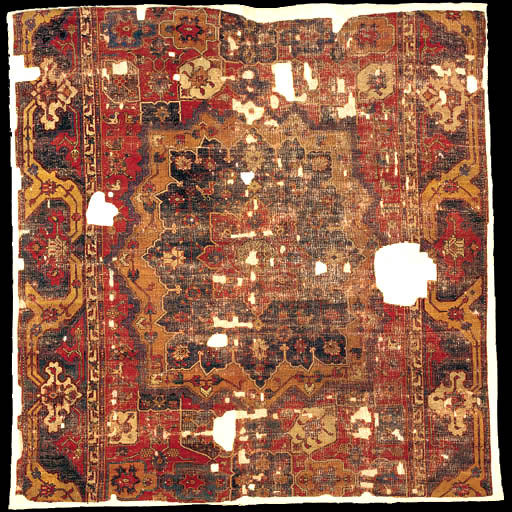|
A TABRIZ MEDALLION AND CARTOUCHE CARPET FRAGMENT
NORTH WEST PERSIA, SECOND HALF 16TH CENTURY
Price Realized £3,525 ($5,058)
Sale Information
Christie's SALE 6435 —
ORIENTAL RUGS AND CARPETS
3 May 2001
London, King Street
Lot Description
A TABRIZ MEDALLION AND CARTOUCHE CARPET FRAGMENT
North West Persia, second half 16th Century
The rust-red field scattered with birds, cartouche panels and angular
flowering vine around a hooked medallion containing a floral centrepiece
issuing palmettes and similar motifs, in a light blue border of polychrome
palmette panels and angular vine meander issuing floral sprays
6ft.4in. x 6ft.1in. (193cm. x 185cm.)
Provenance
Loewe Collection, Venice, from whom purchased circa 1980.
Pre-Lot Text
PROPERTY FROM THE WHER COLLECTION
The Wher Collection was started in 1957, with the intention to include
representatives of all periods and all sectors of textile art, both as
complete pieces and fragments. As in many other collections, with the
passing of decades, the Wher Collection has a policy to sell as well as to
acquire, in order to be better specialised and also to avoid duplicates.
Lot Notes
Medallion and cartouche carpets are among the most impressive of all early
Safavid carpets. Apart from the two examples without medallions and on
silk warps which can be dated to the late Timurid Period, there is a group
of seven large early examples which all have the same field and border
designs but which differ in colour. One of these was in the Bernheimer
Family Collection of Carpets sold in these Rooms 14 February 1996, lot
101, the note to which entry details the other examples. One alteration to
that note is that the Wher Collection example is a fragmentary part of the
same carpet as the Düsseldorf fragment (Concaro, Edouardo and Levi,
Alberto: Sovrani Tappeti, exhibition catalogue, Milan, 1999, no.51, p.74).
The present fragment is a very rare example showing that the design was
woven in other sizes with small alterations. The border here is slightly
simplified from the original, lacking the interlaced second colour of
arabesques. Probably somewhat later than the originals, it probably
represents production at Tabriz after the capital had moved away to Qazvin
in 1548. Another fragmentary example of a medallion and cartouche carpet
of similar original date and size but different border was in a private
German collection (Volkmann, M.: Alte Orientteppiche, ausgewählte Stücke
deutscher Privatsammlungen, Munich, 1985, no.8, pp.30-1).
 |

